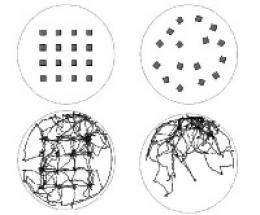Rats say: Manhattan rules!

If you leave it up to the rats, New York City beats New Orleans any day.
This surprising finding comes from new research by Tel Aviv University zoologists and geographers, who are working together to invent a novel way to test urban designers' city plans. Instead of using humans as guinea pigs, the scientists went to their nearby zoo and enlisted lab rats to determine the functionality of theoretical and existing plans.
They've already tried their theory in the academic setting by blindfolding human biology students to confirm that human orientation strategies and instincts are similar to those of their fellow four-legged city dwellers.
"We've found that routes taken by rats and other members of the animal kingdom tend to converge at attractive landmarks, the same way people are attracted, for example, to the Arc de Triumph in Paris," says Prof. David Eilam from TAU's Department of Zoology. "Our research takes the art used by humans to create their towns and cities and turns it back to the animal world for testing. We can look at how rats will react to a city's geography to come up with an optimal urban plan."
A Rat Race on a Straight Track
By building mini-models of city layouts at the Tel Aviv University Research Zoo, Prof. Eilam and his colleagues found that grid-like city layouts ― like that of Manhattan ― are much more rat- and people-friendly than cities with unstructured and winding streets, like those in New Orleans.
"We've built an environment to test city plans, so that 'soul-less' and ineffective new neighborhoods won't be built," Prof. Eilam says. "Using our model of rat behavior, it takes just a few minutes for city planners to test whether a new plan will work. It's a way to avoid disasters and massive expense." He expects that the choices the rats make will eventually be optimized and plugged into a computer tool.
Prof. Eilam and Prof. Juval Portugali, a geography researcher, based their study on the fact that rats build cognitive maps to help orient themselves in nature. In essence, this cognitive "rat map" works to help them know where they are in space and time.
"Manhattan" Navigable, "New Orleans" Disorienting
"We put rats in relatively large areas with objects and routes resembling those in Manhattan," explains Prof. Eilam. The rats, he found, do the same things humans do: They establish a grid system to orient themselves. Using the grid, the rats covered a vast amount of territory, "seeing the sights" quickly. In contrast, rats in an irregular plan resembling New Orleans' failed to move far from where they started and didn't cover much territory, despite travelling the same distances as the "Manhattan rats."
Prof. Eilam and his colleagues say that urban planners can use this rat behavior model to test how the public will respond to new objects -- such as tall buildings or cooperative housing -- in the real world.
Source: American Friends of Tel Aviv University
















